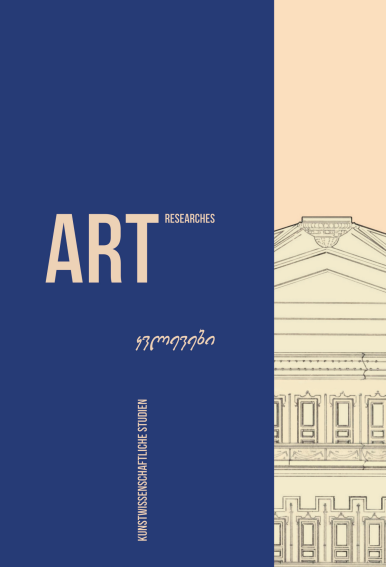აწმყო - „დასწრება“ , წარსული - „კვალი“
Main Article Content
ანოტაცია
The article “Present - “presence”, past - “trace” deals with the conceptual conception of time in fi lm art. Postmodernism poses other artistic challenges - style, meaning and form must meet these demands.
The epoch of postmodernism has globally changed the view of the world and the lifestyle of man. The changes also aff ect the foundations of culture, the usual values have been revalued. The new world of the second half of the 20th century began with the numerous opposing views, events, meanings, diff erences and similarities that emerged in the reality of ,modernity. This period is also characterized by the diversity of cultural spaces and styles, by the manifold currents of amateur art of the masses, the artistic political subcultures that spontaneously formed alongside professional art.
The fi lm of postmodernism carries within itself the causal connections of the “decentered world” and the amorphous structure without “orientation of values”, the specifi c view of the world, which as hierarchical is composed of chaotic fragments. Although, its simple facade hides the multi-layered, stylish, multifaceted depth, which is provided with many codes. Each layer establishes a relationship with the neighbouring layer, and so does every other layer with each other, with the viewer. The most important thing is the relationships that have been created, not the eff ort the author makes in the fi nale of the work (whether it is a book or a fi lm) to just finish it. And may this fi nale also contain the most important meaning.
This principle of postmodern cinematography, this dynamic, changeable and incomprehensible “playing structure” with the constant play of meanings, elements and layers existing in it, with the constant struggle - the “game of diff erence” - of agreement and diff erence, the “neutral” ambiguity became in Georgian cinematography a possibility of escape from Soviet censorship, from the disguise and hidden context. When studying postmodern film and in order to uncover the senses that have changed in it, as well as to determine the “differences” to oneself, the observation of the relations between the elements that exist in it, the play of layers and the spread of narration in fi lm plays an important role.
Each fl ow and direction within the framework of the style regulates in some way the artistic reality and its re-fi xed coordinates of time and space, since they are the elements of the localization of the content, the continuous reproduction of the events, the formation of the style: be it the free asynchronous volatility of time according to the function of the “third meaning” of Kuleshov Eisenstein’s montage, or the temporally uninterrupted (like a rope effect) narrative of Hitchcock. At the stage of postmodernism, the artistic meaning of film is even more weighty, accentuated in terms of content, deliberately reinterpreted, which becomes a factor in the fundamental reinterpretation of the work, a factor in interpreting it differently and exposing the contradictions that exist in it.
The article pays special attention to the concepts of Jacques Derrida’s theory of deconstruction - “presence” - “absence”, “trace” and “difference”. Special interest is given to the postmodernist “diff erentiation” of the conception of reality in general and the character of the temporal and the spatial; also the specifi cs of the postmodernist way of seeing that are connected with these concepts and in general with the change of sense/content.
